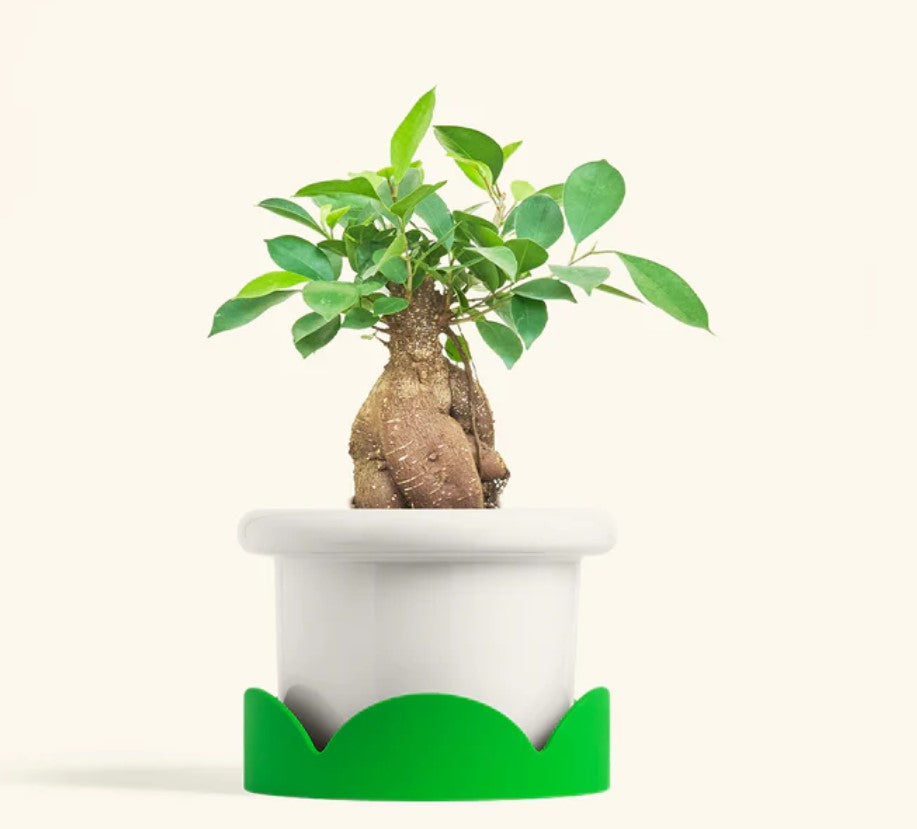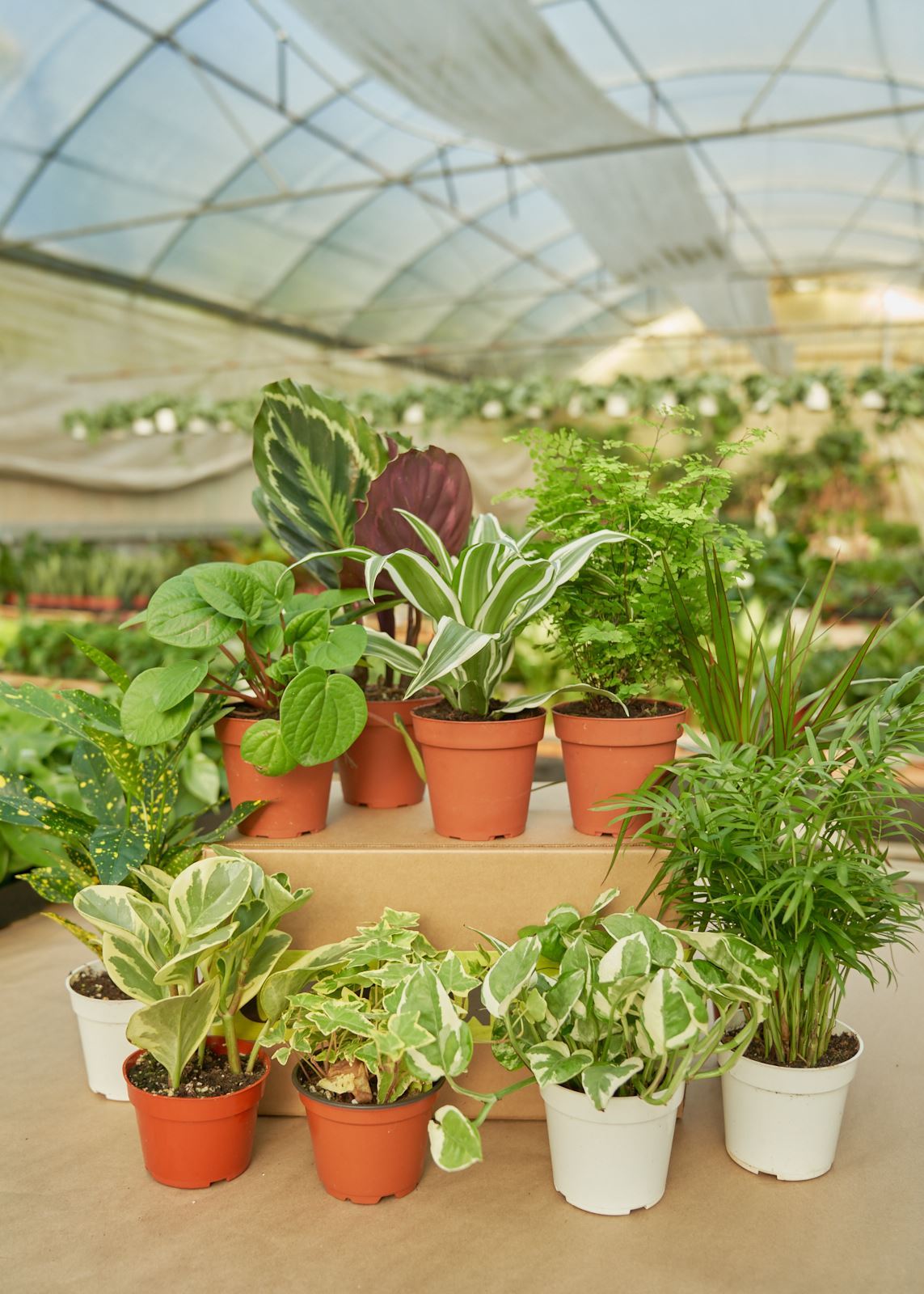Ficus Microcarpa Ginseng Care: The Complete Guide & Troubleshooting Tips

If you’re a fan of compact, Bonsai-like houseplants, you should give the Ficus Ginseng a thought. This visually appealing ficus plant is widely grown in Southeast Asia and some parts of Australia for its thick, waxy leaves and unique look. It may not be a safe bet for your pets due to its toxicity, but its reputation for resilience makes it a favorite among many plant enthusiasts.
In this comprehensive guide, we’ll dive into how to care for Ginseng Ficus easily and without too much effort. From Ficus Ginseng light requirements and watering to pruning and propagation, here’s everything you need to know about Ficus Microcarpa care. So, let’s start without further ado.
About Ficus Microcarpa Ginseng

Ficus 'Ginseng', or Ficus Microcarpa Ginseng, is a small Bonsai plant that features thick, twisty roots and glossy green leaves. It hails from India to China and Japan, through Southeast Asia, and is a member of the fig family, Moraceae. People love a Ficus Ginseng plant mostly because it’s not a drama queen when it comes to maintenance. If you forgot to water it for a day or two, it barely notices. Just provide it with a cozy spot, with temperatures between 60°F and 75°F, and it’s good to go for years.
Ficus Ginseng helps clean the air by absorbing harmful pollutants and adds lush greenery to the home. Symbolically, the Ficus Ginseng represents resilience, strength, and longevity. In Feng Shui, it’s said to bring prosperity, abundance, and positive energy into the home or workplace. But is Ficus Ginseng safe for pets? Be careful, the Ficus Microcarpa Ginseng isn’t safe for pets if they eat the leaves. It can cause mild stomach problems, apart from serious gastrointestinal signs, including vomiting and diarrhea, in some cases.
Ficus Ginseng Care: Growing Guide & Tips

An easy-to-grow plant that adds beauty to any home or office space, growing Ficus Ginseng becomes super easy with the right light, water, and care.
Ficus Ginseng: Light Requirements and Watering
Ficus Ginseng prefers bright, indirect light and requires careful watering to prevent waterlogging or dry soil. Let the top layer of the soil dry slightly between waterings to keep the potted plant healthy.
Does Ginseng Like Full Sun?
Ficus Ginseng Bonsai likes bright light, but try to avoid full sun, unless it’s for a few hours in the morning. Too much direct sunlight can burn its soft, waxy leaves. It’s best to place it near a window with filtered light or in a spot with morning sun and afternoon shade to keep it healthy.
How Much Light Does a Ginseng Ficus Need?
To grow well indoors, a Ginseng Ficus needs bright, indirect light for around 6-8 hours each day. Avoid dark corners or places with very little or no sunlight. A spot near a sunny window, but not directly in the strong sun, is what your houseplant needs.
How Often Should Ficus Ginseng Be Watered?
A Ficus Ginseng plant should be watered only when the top inch of soil feels dry. In warmer months, this may be twice to thrice a week. In winter, water less to prevent overwatering. Irrespective of the season, always check the soil first. Avoid deep watering, as the plant will suffer if it is standing in water.
Ficus Ginseng: Humidity & Temperature Tolerance
This gorgeous ficus plant prefers warm weather and medium humidity. It thrives in USDA zones 10-12 and should be kept away from cold drafts or sudden temperature changes for overall well-being.
Does Ficus Ginseng Like Humidity?
Yes, a Ficus Microcarpa Ginseng likes humidity. The sweet spot is between 60-75% relative humidity, which mirrors its native tropical environment. You can monitor the humidity levels using a hygrometer placed near your plant and adjust it if needed with the help of a pebble tray filled with water.
What Is the Ideal Temperature for Ficus Ginseng?
The ideal temperature range for Ficus Ginseng is from 60°F to 75°F, as the plant is native to warmer climates. While slight temperature variations are tolerable, extreme fluctuations may cause the Ficus Ginseng plant to show signs of distress.
Ginseng Ficus: Soil, Repotting, and Feeding

Ficus Ginseng Bonsai needs well-draining soil to grow and should be repotted every 2-3 years. Use a light fertilizer during spring and summer to replenish the soil with micronutrients.
What Kind of Soil Does Ginseng Like?
The Ficus Ginseng likes moist, well-drained, and fertile soil that’s rich in calcium and organic matter. This makes loose dark soil the best choice for growing the plant; Ginseng won’t grow in compacted or waterlogged soil. For the pH, it should be between 5.5 and 6.0 for the right balance of acidity and alkalinity.
What Fertilizer for Ginseng Ficus?
Any multi-purpose liquid, granular, or slow-release formulation-based fertilizer is suitable for Ficus Ginseng. Ensure that you dilute the mixture by 50% before feeding it every month during the growing season (early spring and summer) in temperate climates. Fish emulsion or seaweed extract are two excellent choices if you're looking for something organic.
When Should You Repot a Ficus Ginseng?
You should repot a Ficus Ginseng when the plant becomes root-bound. Ideally, Ficus Ginseng should be repotted in a bigger pot every 2-3 years, like Monstera and some other houseplants, during the spring or summer months to avoid stress. Avoid repotting in winter, as the plant may struggle adjusting to its new home.
Ficus Ginseng: Propagation
You can grow new Ficus Ginseng plants by using stem cuttings or air-layering. To grow from cuttings, take a healthy stem with 3-4 leaves and cut it just below a node, which is the bump where new leaves grow. Submerge the cuttings in water or insert them in moist soil. Keep the young Ficus bonsai plants in a warm area with bright, indirect light. After a few weeks, roots will start to grow.
Air-layering is another method you can use to propagate the Ficus Microcarpa Ginseng. Select a healthy branch, cut a small ring of bark, and wrap wet moss around it. Cover it with plastic to increase the humidity. After some weeks, roots will grow from that spot. Then, you can cut and plant it.
Ginseng Ficus: Pruning & Common Problems

Pruning the Ginseng Ficus is as important as it is for other houseplants. It promotes new growth and keeps the plant in the desired shape. Early spring or summer is the best time to prune a Ficus Ginseng plant to prevent stressing the plant. You should also monitor your Ginseng Ficus for signs of distress and other common issues, such as leaf drop, yellowing, and root rot.
Why Is My Ficus Ginseng Dropping Leaves?
Your Ficus Ginseng Bonsai may be losing leaves due to various environmental factors, including inconsistent watering, insufficient light, cold drafts, high temperatures, and more. Adjust your Ficus Ginseng Bonsai care routine to prevent further loss of leaves.
Why Are My Ficus Ginseng Leaves Turning Yellow?
If the leaves of your Ficus Ginseng are turning yellow, it may be due to under- or overwatering, root rot, too much sunlight, pest infestations, or nutrient deficiencies. We suggest reducing your watering frequency, moving the plant to a spot with indirect light, or repotting Ficus Ginseng in fresh, nutrient-rich soil.
Ficus Ginseng Care: FAQs
Q: Are Ficus Ginseng hard to care for?
A: No, Ficus Ginseng isn’t hard to care for. It’s one of the easiest indoor plants to grow, ideal for beginners and plant lovers with busy schedules. Just give it some sunlight, and water it when the soil is dry to the touch to prevent overwatering. It doesn’t need much attention. Even if you forget it for a few days, it usually stays healthy.
Q: Do Ficus Ginseng like to be misted?
A: Yes, a Ficus Ginseng plant likes a little misting now and then. It helps keep the leaves fresh and adds some moisture to the air, especially in dry rooms. Just ensure you use clean water and spray lightly on the leaves. Don’t mist too much, though. A few times a week is enough to keep the Ficus Microcarpa Ginseng looking green and healthy.
Q: How long does Ficus Ginseng live?
A: Ficus Ginseng can typically live for 15-20 years, sometimes longer if you treat it well. Keep it in indirect sunlight, water it regularly, and don’t change its location too often. A Ficus Ginseng Bonsai grows slowly, maintaining its small stature for a long time. This makes it perfect for keeping indoors permanently.
Q: Does Ficus Ginseng like to be root-bound?
A: Yes, Ficus Ginseng actually likes to be root-bound. That means it doesn’t mind when its roots are a bit crowded. You don’t have to change the pot too often. Repot it every 2-3 years or when the roots really start to push out through the holes of the container. This helps it stay healthy without growing too fast or too big.
Q: Is Ficus Ginseng a lucky plant?
A: Yes, many people believe Ficus Ginseng is a lucky plant. It’s said to bring peace, strength, and good energy into the home. Some even place a Ginseng tree near the entrance or in the living room for better luck. The various Ficus Ginseng Bonsai benefits make it a great gift, too!
Conclusion
Ficus Microcarpa Ginseng care is easy if you provide your green companion with the right light, water, and a warm place to grow. Don’t water too much and keep it away from cold drafts. If the leaves of your Ficus Ginseng plant drop or turn yellow, adjust your care routine and check for pests. With some attention and a little effort, this plant can thrive for 15+ years and look great in your home.
You can pair your Ficus Ginseng with Monstera or Snake Plants, boasting similar benefits, such as air-purifying properties and low-maintenance needs.
